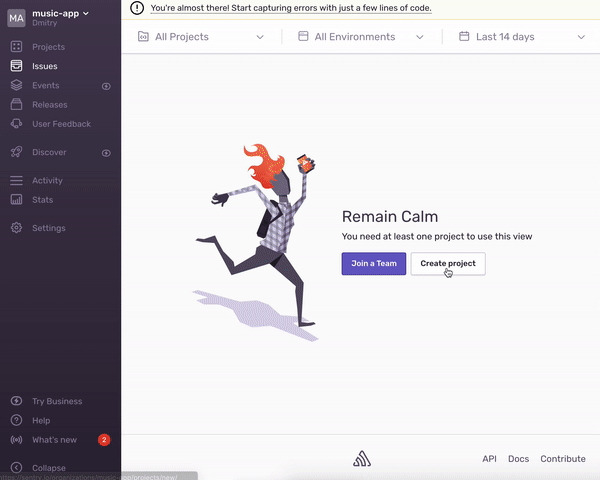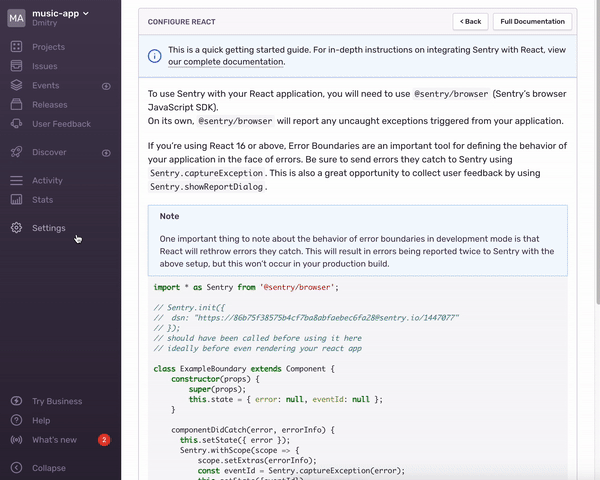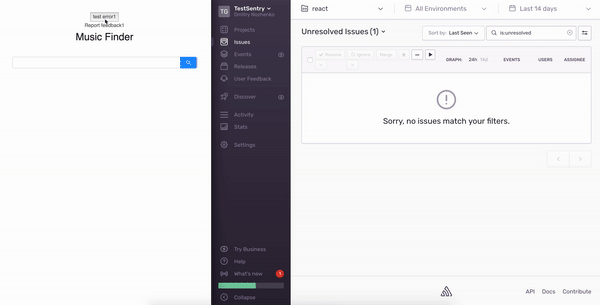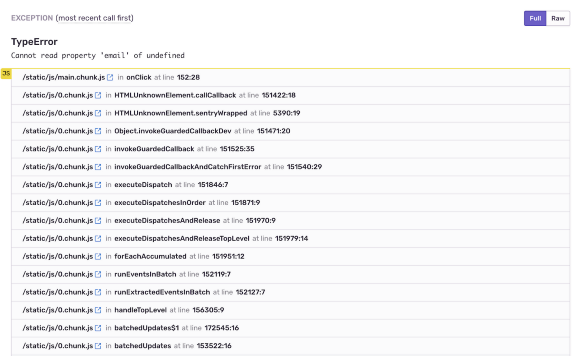
Today, I'm going to walk you through real-time error tracking in a React app. A frontend application is not typically used for bug tracking. Some companies often put off tracking bugs by returning to it after documentation, tests, and more. However, if you can change your product for the better, then just do it!
1. Why do you need Sentry?
I am assuming you are interested in tracking bugs during production
Do you think this is not enough?
Ok, let's see the details.
Top reasons to use Sentry for developers:
- Eliminates the risk of deploying buggy code
- QA assistance in code testing
- Get quick notifications of problems
- The ability to quickly fix errors
- Getting a convenient display of errors in the admin panel
- Sorting errors by user / browser segment
The main reasons for the CEO / Lead of the project
- Saving money (Sentry can be installed on your servers)
- Getting user feedback
- Real-time understanding of what's wrong with your project
- Understanding the number of problems people have with your application
- Help finding places your developers have made a mistake
, . , Sentry.
.
?

Sentry?
Sentry – , , . , . Sentry JavaScript, Node, Python, PHP, Ruby, Java .

2.
- Sentry . , . ( Sentry )
- . ( React. « »)

. , Sentry , :
import * as Sentry from '@sentry/browser';
// Sentry.init({
// dsn: "<https://63bbb258ca4346139ee533576e17ac46@sentry.io/1432138>"
// });
// should have been called before using it here
// ideally before even rendering your react app
class ExampleBoundary extends Component {
constructor(props) {
super(props);
this.state = { error: null };
}
componentDidCatch(error, errorInfo) {
this.setState({ error });
Sentry.withScope(scope => {
Object.keys(errorInfo).forEach(key => {
scope.setExtra(key, errorInfo[key]);
});
Sentry.captureException(error);
});
}
render() {
if (this.state.error) {
//render fallback UI
return (
<a onClick={() => Sentry.showReportDialog()}>Report feedback</a>
);
} else {
//when there's not an error, render children untouched
return this.props.children;
}
}
}Sentry , , . . , . , !
3. React Sentry
npm .
npm i @sentry/browserSentry :
Sentry.init({
// dsn: #dsnUrl,
});DSN Projects -> Settings -> Client Keys. .

componentDidCatch(error, errorInfo) {
Sentry.withScope(scope => {
Object.keys(errorInfo).forEach(key => {
scope.setExtra(key, errorInfo[key]);
});
Sentry.captureException(error);
});
}4.
API Deezer. . . "undefined"
, console.log user.email. : Uncaught TypeError ( email) - . Javascript.
<button type="button" onClick={() => console.log(user.email)}>
Test Error button
</button>:
import React, { Component } from "react";
import { connect } from "react-redux";
import { Input, List, Skeleton, Avatar } from "antd";
import * as Sentry from "@sentry/browser";
import getList from "../store/actions/getList";
const Search = Input.Search;
const mapState = state => ({
list: state.root.list,
loading: state.root.loading
});
const mapDispatch = {
getList
};
class Container extends Component {
constructor(props) {
super(props);
Sentry.init({
dsn: "https://fc0edcf6927a4397855797a033f04085@sentry.io/1417586",
});
}
componentDidCatch(error, errorInfo) {
Sentry.withScope(scope => {
Object.keys(errorInfo).forEach(key => {
scope.setExtra(key, errorInfo[key]);
});
Sentry.captureException(error);
});
}
render() {
const { list, loading, getList } = this.props;
const user = undefined;
return (
<div className="App">
<button
type="button"
onClick={() => console.log(user.email)}
>
test error1
</button>
<div onClick={() => Sentry.showReportDialog()}>Report feedback1</div>
<h1>Music Finder</h1>
<br />
<Search onSearch={value => getList(value)} enterButton />
{loading && <Skeleton avatar title={false} loading={true} active />}
{!loading && (
<List
itemLayout="horizontal"
dataSource={list}
locale={{ emptyText: <div /> }}
renderItem={item => (
<List.Item>
<List.Item.Meta
avatar={<Avatar src={item.artist.picture} />}
title={item.title}
description={item.artist.name}
/>
</List.Item>
)}
/>
)}
</div>
);
}
}
export default connect(
mapState,
mapDispatch
)(Container);.


Whoo-hoo!

, .

. , , , . ReactJS, .
, , .
. , Dmitry Nozhenko source map. , Dmitry Nozhenko, .
5. Sentry API
. javascript . , XHR?
Sentry . api.
Sentry.captureException(err), , , , . .
superagent
.get(`https://deezerdevs-deezer.p.rapidapi.com/search?q=${query}`)
.set("X-RapidAPI-Key", #id_key)
.end((err, response) => {
if (err) {
Sentry.configureScope(
scope => scope
.setUser({"email": "john.doe@example.com"})
.setLevel("Error")
);
return Sentry.captureException(err);
}
if (response) {
return dispatch(setList(response.body.data));
}
});API catch.
import * as Sentry from "@sentry/browser";
export const apiCatch = (error, getState) => {
const store = getState();
const storeStringify = JSON.stringify(store);
const { root: { user: { email } } } = store;
Sentry.configureScope(
scope => scope
.setLevel("Error")
.setUser({ email })
.setExtra("store", storeStringify)
);
// Sentry.showReportDialog(); - If you want get users feedback on error
return Sentry.captureException(error);
};api.
export default query => (dispatch, getState) => {
superagent
.get(`https://deezerdevs-deezer.p.rapidapi.com/search?q=${query}`)
.set("X-RapidAPI-Key", #id_key)
.end((error, response) => {
if (error) {
return apiCatch(error, getState)
}
if (response) {
return dispatch(setList(response.body.data));
}
});
};:
- setLevel sentry. — ‘fatal’, ‘error’, ‘warning’, ‘log’, ‘info, ‘debug’, ‘critical’).
- setUser (id, , . .).
- setExtra , , , .
If you want to get user feedback on a bug, you should use the showReportDialog function.
Sentry.showReportDialog();Output:
Today we described one way to integrate Sentry into a React app.
→ Telegram chat via Sentry